Accepted Scientific Name: Xerophyta retinervis Baker
J. Bot. 13: 233 1875
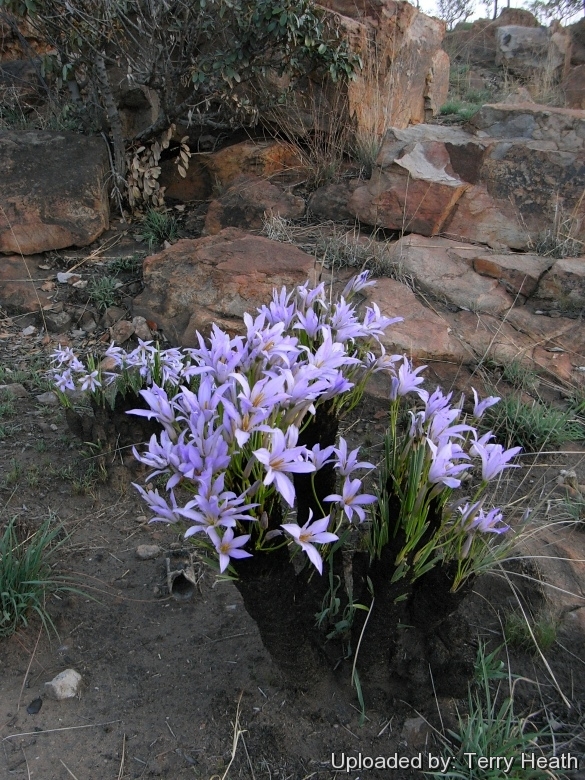
Barbacenia retinervis (Xerophyta retinervis) Photo by: Terry Heath
Origin and Habitat: Eastern South Africa (widespread, but not abundant in Limpopo, Gauteng and Mpumalanga provinces and in Swaziland)
Habitat: Xerophyta retinervisSN|18092]]SN|18092]] occupies a very specialized ecological niche in seasonally high rainfall regions, growing in in grasslands on rocky outcrops and cliffs with shallow soil. On such rocks, weathering leads to cracks and ridges where organic matter like leaves, and dust, fill in the irregularities, forming mats about a centimeter thick. Mosses form on these mats, and various plants sprout in these organic mats, sending their roots quite some distance horizontally, but never more than a centimeter or two deep. The mats enlarge over time. In the summer rainy season, the mats are probably always moist to wet. Once the leaves of the Xerophyta retinervisSN|18092]]SN|18092]] are air-dry, they can remain viable for prolonged periods. The dry 'winter' season lasts 5 to 6 months.
Synonyms:
See all synonyms of Xerophyta retinervis
back
Accepted name in llifle Database:Xerophyta retinervis BakerJ. Bot. 13: 233 1875Synonymy: 6
back
Common Names include:
ENGLISH: Wonder bush, Black stick lily, Resurrection plant, Baboon tail, Monkeys Tail
AFRIKAANS (Afrikaans): Bobbejaanstert, Besembos
SWAZI: Sifunti
ZULU (isiZulu): Isiqumama, Isiphemba, Isiphmba, Isigqumana
Description: Xerophyta retinervisSN|18092]]SN|18092]] is a perennial shrub, usually about 0.6 m tall, tipped with elongated strap shaped leaves, but can grow up to 1.8 m high in favourable conditions.
Stem: Dark, upright, grey to black tufted, very robust, solitary or (usually) irregularly branched; its dark stumpy appearance is a conspicuous feature.
Roots: Fibrous.
Leaves: Long light green, narrow, lanceolate in clusters spread over the dark stem.
Flowers: The deep mauve or pale blue, borne on long thin stalks, they are sweetly scented large and very attractive. Perianth segments usually more than 4 cm long.
Blooming season: Plants tend to flower irregularly at the beginning of the summer season, just as the new rains start.
Fruit: The fruits are capsules. The seed is set quickly and ripens in about 6 weeks.
Notes: Dehydration
One of the major consequences of drought stress is the loss of water from the plant cells. This leads to the concentration of ions in the cell protoplasm. Many of these ions are toxic to plants at high concentrations. In this condition, whatever liquid is left in the cell has a high viscosity, increasing the chances of molecular interactions that can cause proteins to denature, and membranes to fuse . This causes problems for the plant, because if a broad band of proteins have been denatured, they can't continue with their normal metabolic cycles. All plants display some ability to tolerate environmental stress to varying degrees. However, the resurrection plants like Xerophyta, take this a step further. This is not entirely unusual. An array of metabolic pathways have been found to be activated under conditions of water deficit in other plants. What is important is that Xerophyta uses its metabolic strategies more efficiently and that allow the plant to tolerate extreme environments.
Bibliography: Major references and further lectures
1) Braam Van Wyk “A Photographic Guide to Wild Flowers of South Africa” Struik, 2000
2) Ernst Schmidt, Mervyn Lötter, Warren MacCleland “Trees and Shrubs of Mpumalanga and Kruger National Park” Jacana Media, 2002
3) Ayensu, E.S. 1973. “Biological and morphological aspects of the Velloziaceae.” Biotropica 5: 135-149.
4) Dyer, R.A. 1942. “Vellozia retinervis. The Flowering Plants of Africa” 22: t. 856.
5) Farrant, J.M. 2000. “A comparison of mechanisms of dessication tolerance among three angiosperm resurrection plant species.” Plant Ecology 151: 29-39.
6) Nichols, G. 2005. “Growing rare plants. A practical handbook on propagating the threatened plants of southern Africa.” Southern African Botanical Diversity Network Report No. 36. SABONET, Pretoria.
7) Pooley, E. 1998. “A field guide to the wild flowers of KwaZulu-Natal and the Eastern Region.” Natal Flora Publications Trust, Durban.
8) Van Wyk, B-E., Van Oudtshoorn, B. & Gericke, N. 1997. “Medicinal plants of South Africa.” Briza Publications, Pretoria.
 Barbacenia retinervis (Xerophyta retinervis) Photo by: Valentino Vallicelli
Barbacenia retinervis (Xerophyta retinervis) Photo by: Valentino Vallicelli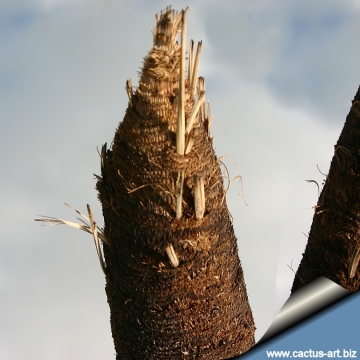 Barbacenia retinervis (Xerophyta retinervis) Photo by: Cactus Art
Barbacenia retinervis (Xerophyta retinervis) Photo by: Cactus Art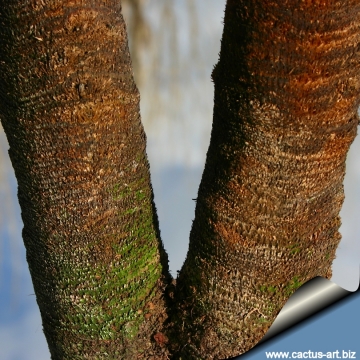 Barbacenia retinervis (Xerophyta retinervis) Photo by: Cactus Art
Barbacenia retinervis (Xerophyta retinervis) Photo by: Cactus Art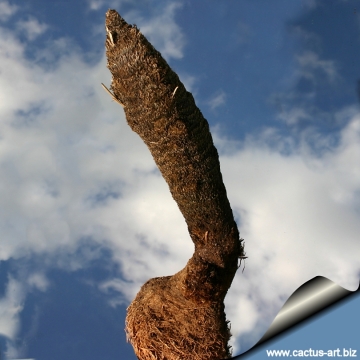 Barbacenia retinervis (Xerophyta retinervis) Photo by: Cactus Art
Barbacenia retinervis (Xerophyta retinervis) Photo by: Cactus Art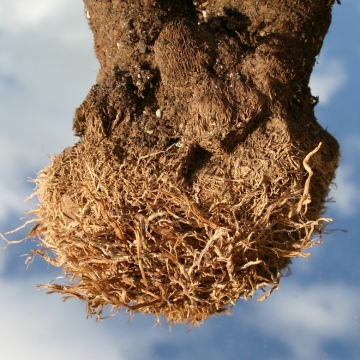 Barbacenia retinervis (Xerophyta retinervis) Photo by: Cactus Art
Barbacenia retinervis (Xerophyta retinervis) Photo by: Cactus ArtSend a photo of this plant.The gallery now contains thousands of pictures, however it is possible to do even more. We are, of course, seeking photos of species not yet shown in the gallery but not only that, we are also looking for better pictures than those already present.
Read More... Cultivation and Propagation: General succulent culture is needed. The water available heavily influences their growth. Plants have developed astonishing strategies to survive lengthy periods of drought unharmed, they dry out, and in a desiccated state can withstand drought, often for months. When watered, even after a long period of drought, the plants can quickly regain an active state. With several plants of this kind, the dried-out leaves turn green after just a few hours. Xerophyta retinervisSN|18092]]SN|18092]] can grow in the same pot for many years, never needing to re-pot it. It is very cold hardy to at least -12° C.
Traditional uses: This plant has many medicinal applications, it is known in Zulu as 'isiphemba' or 'isiqumama' The roots are smoked to relieve asthma and smoke from the whole plant is used to stop nosebleeds. Stem bark preparations are reported to have anti-inflammatory and analgesic properties. The active ingredient, called amentoflavone, is also found in gingko extract.
Propagation: Usually propagated by seed, sow the seed on a seedling mix that is able to hold water, as you would for cacti. (E.g. cover the seed tray with a plastic baggie and set it in bright shade ) They sprout quickly. But keep the water level in the container high. Watering the seedlings (Preferably) from below, or leaving the tray sitting in a bath of water. Seed germinates in about 2–4 weeks. Leave the seedlings in the trays for a season to get root-bound. Divide them just before the second growing season starts. The seedling grows fairly slowly (only a few mm per year) but when acclimatized they can grow faster.















